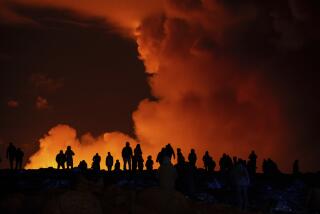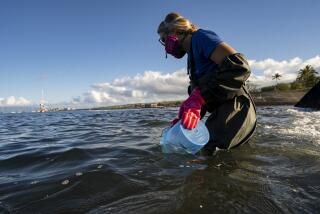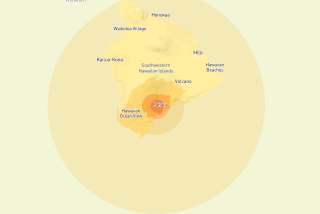Hawaii Island isn’t itself anymore. Lava and quakes have transformed it in interesting ways
The island of Hawaii was created by five volcanoes. In 2018, one of them seemed intent on destroying parts of it.
Kilauea, which has been erupting continually since 1983 at a volcanic cone called Puu Oo Crater, threw a geological tantrum in the spring that buried hundreds of houses and covered roads in a remote location on the east side of the island.
It also created a cloak of vog (volcanic smog) that fouled the air, dulled the skies and scared away scores of tourists and, with them, nearly half-a-billion dollars.
And then the eight-mile-long lava flow stopped, and the earthquakes, one of which registered 6.9, subsided.
Hawaii Volcanoes National Park, country roads and state parks have reopened, and visitors are starting to return, drawn, in part, by good airfares and room availability.
Here are some ways the island has changed.
The volcano and the lava
On April 30, the floor of Puu Oo Crater collapsed. Its lava lake as well as the one in Halemaumau Crater drained, sending the lava underground to the volcano’s eastern flank. Twenty-four fissures then ruptured, spewing fountains of lava. Earthquakes at the summit became a daily occurrence.
Several black sand beaches were created out of the lava flows. The largest one, at Isaac Hale Beach Park, now attracts hundreds of visitors a day.
RELATED: From destruction, creation: A new black sand beach is born on the island of Hawaii »
The activity produced, in the words of one U.S. Geological Survey scientist, a visually spectacular landscape and a story to match.
“I feel like it’s still an incredible visitor destination,” said Tina Neal, scientist in charge at USGS Hawaiian Volcano Observatory, established in 1912 to study active volcanoes and earthquakes in Hawaii.
Among the benefits of the cessation: The vog is nearly gone, and as a result, the entire island is enjoying blue skies that haven’t been this clear in decades.
Although you can no longer see lava up close or glowing from a distance, that doesn’t mean you will never have a chance. Kilauea will erupt again.
Changes at the park
The 505-square-mile Hawaii Volcanoes National Park, shaken by a series of strong earthquakes, was closed early May to late September. It’s now back on its 24-hours-a-day schedule. (The park is accessible during the government’s partial shutdown, but some services may be curtailed.)
“We’re so excited to be open again, to have our visitors back again and to share what is basically a new park, and that’s been a defining quality of this park since we were founded 102 years ago,” said Jessica Ferracane, the park’s public affairs specialist. “When you’re home to two active volcanoes, Kilauea and Mauna Loa, they’re constantly reshaping what we do and how we respond to it.”
The most dramatic changes are the loss of Halemaumau’s lava lake and the quadrupling in size of its crater. In some places, it’s 2,000 feet deep, almost 10 times its previous depth.
Most of the park’s facilities and trails are now open such as the popular Steam Vents Trail, Sulphur Banks Trail, Devastation Trail, Puu Loa Petroglyphs Trail, the back-country trails and Chain of Craters Road to the Holei Sea Arch.
Also open is the historic Volcano House, which sustained minor damage and was closed for repairs. “We got very lucky,” said Orin McCann, the general manager.
The hotel reopened in October, but it’s still easy to get a room or restaurant reservation. Dining-room walk-ins are still being accommodated, but the expected increase in business may put an end to that.
The Namakanipaio campgrounds and cabins, outside the national park, is expected to reopen this month. Guests will find several upgrades, including landscaping, new electronic locks on all cabins, fresh gravel and new grills.
Several trails, roads and overlooks are still closed (see sidebar), and there is no timeline for their reopening. Ongoing assessments are being made, and the national park doesn’t want to rush them.
The Thomas A. Jaggar Museum, which suffered severe structural damage, is also closed, and its future is undecided. This museum of volcanology, named for the founder of the Hawaiian Volcanoes Observatory, also displays artifacts and offers cultural exhibits.
Meanwhile, visitors can discover new sights that were revealed by the 2018 eruption.
For instance, the best closeup view of the enlarged Halemaumau Crater is now from a nearly mile-long hike to Keanakakoi Crater, off Crater Rim Drive.
That section of road, closed when the crater erupted in 2008, has been open to hikers and bicyclists since 2011. It now has cracks in the road from recent earthquakes. If you look closely, you’ll see where a part of the closed road fell into the crater.
“That’s kind of the new thing to go and see,” Ferracane said. “Visitors always ask us what’s new and what can we see since there’s no lava. Well, go see the road to nowhere.”
A new museum
Many of the historic items from the Jaggar Museum are in storage, except for some on loan to the Pahoa Lava Zone Museum (15-2962 Pahoa Village Road, Pahoa; donations accepted), which opened in December.
On display are artworks by the late Herb Kane illustrating the history and culture of the Hawaiian and Polynesian islands, and a few exhibit props explaining the geology of beaches and magma chambers.
Alongside the Jaggar Museum items are its own displays of photos and videos from the 2018 eruption, geological specimens of Pele’s hair (thin strands of volcanic glass) and Pele’s tears (solidified lava droplets) and even a beehive that was turned to stone.
“We’re trying to help guide visitors through the history of the geology of the island with a focus on the 2014 and 2018 eruptions, so history and cultural aspects are explained as well as a step-by-step guide of the May eruptions,” said Amedeo Markoff, promotions chair for the Mainstreet Pahoa Assn. and gallery owner of Puna Gallery and Gift Emporium.
Markoff says a new cultural park will open this month in Pahoa, where visitors can get a deeper understanding of the volcanoes’ cultural significance. There will be Hawaiian games, hula, canoe carvers and storytellers. Visitors can stop by the museum to learn more.
Still closed within Hawaii Volcanoes National Park:
► Crater Rim Drive west of Kilauea Military Camp and west of Keanakakoi Overlook
►Most of Crater Rim Trail (except for the area between Volcano House and Kilauea Military Camp)
►Most of the Kau Desert Trail (except for Hawaii 11 to the Footprints Shelter)
More to Read
Sign up for The Wild
We’ll help you find the best places to hike, bike and run, as well as the perfect silent spots for meditation and yoga.
You may occasionally receive promotional content from the Los Angeles Times.






